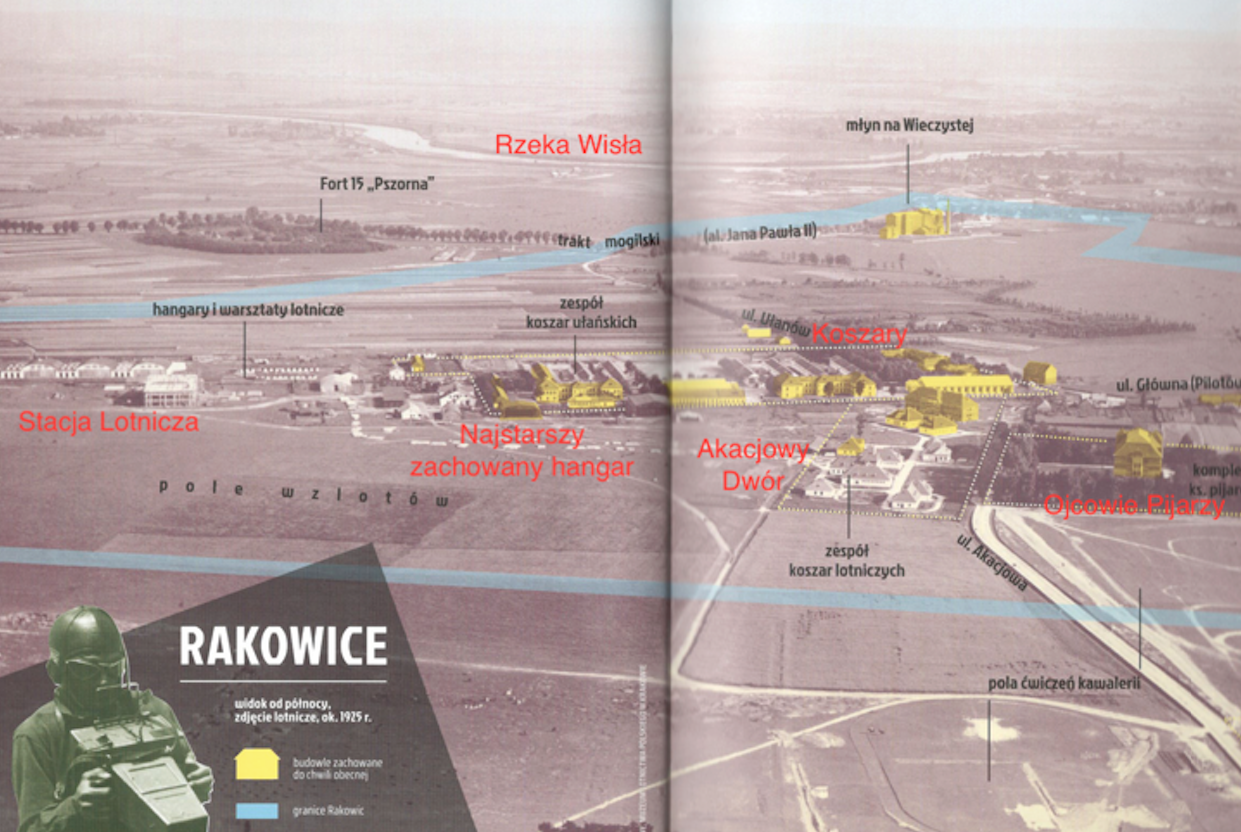Kraków 2018-01-25
Rakowice – Czyżyny airport.
History airport.
Description to the photo: The buildings marked in yellow are buildings that have existed to the present day.
The beginning of the airport were the decisions of Austrian commanders to create Air Troops at the already existing Aeronautical (balloon) Troops. The construction of Flugpark No. 7 (air park) is planned in Krakow. In 1912, the Austrian authorities purchased part of the land from the Piarist Fathers for the purpose of flug-park and airport. It was the area south-east of the barracks. Initially, the airport only had a marked out landing area, technical port and social facilities. Already the first experiences of the Great World War caused a dynamic development of aviation. Not only did the airplanes themselves change, but the number of ground personnel, the necessary equipment and the appropriate number of horses increased.
The first hangars, known at that time as fire stations, were built along the northern side of the Uhlan unit. Three identical hangars were built, of a wooden structure with a gable roof, with broken edges and sloping walls. Their wooden gates were moved on metal wheels. Roof and walls covered with tar paper. They were about 25 mx 25 m. They looked more like barns in general. Until now (2018) one of these hangars has been preserved, the one on the eastern side.
In 1915, the expansion of the Rakowice Airport began. In the period 1916-1917, a complex of air barracks was erected (at today’s Akacjowa Street and Ernesta Cieślewski) according to the design of Karl Theisz with the participation of Tadeusz Stryjewski and Franciszek Mączyński, in which the pre-war concept of the "Garden for aviators" by Paul and Andre Vera was used. Paul Vera (1882–1957) was a French painter, designer and pioneer of the Art Deco style. He worked with his brother Andre, a garden designer. The brothers wanted utility items to be beautiful at the same time and that people should feel good among them. The "garden for aviators" in Rakowice has never been completed.
The technical facilities at Rakowice Airport have been greatly expanded, including workshops, warehouses, petrol stations and lubricants. They were located in the place of the later large hangars and the current car garages of local residents. At the end of the Great World War, the technical base, the so-called Air Station, was very large. There were four brick halls with arched roofs connected with social and storage buildings. There were also other brick and wooden buildings. Until now, none of these objects has survived. An air station is a type of an airplane park in which overhauls, repairs, and inspections of airframes and aircraft engines are performed. The entire area of the Aviation Station is fenced. It has an entrance gate "from the city side" and a very wide gate leading to the landing area through which planes are taxied.
In December 1914, the Aviation Division had six airplanes, including: Albatros, Aviatik, Lohner, DFW. They made reconnaissance flights. As a result, the Austrians managed to stop the Ruthenians during the Limanowsko-Łapanowska operation and prevent an attack on Krakow.
The rejection of the front far to the east changed the importance of Rakowice Airport. From the frontline airport it has become a deep hinterland airport and a very important training and repair center as well as a transport hub. From 1916, a temporary and then regular airmail line operated on the Vienna-Krakow-Lviv-Kiev route.
In 1917, the take-off area already measures 500 m x 800 m.
Written by Karol Placha Hetman

